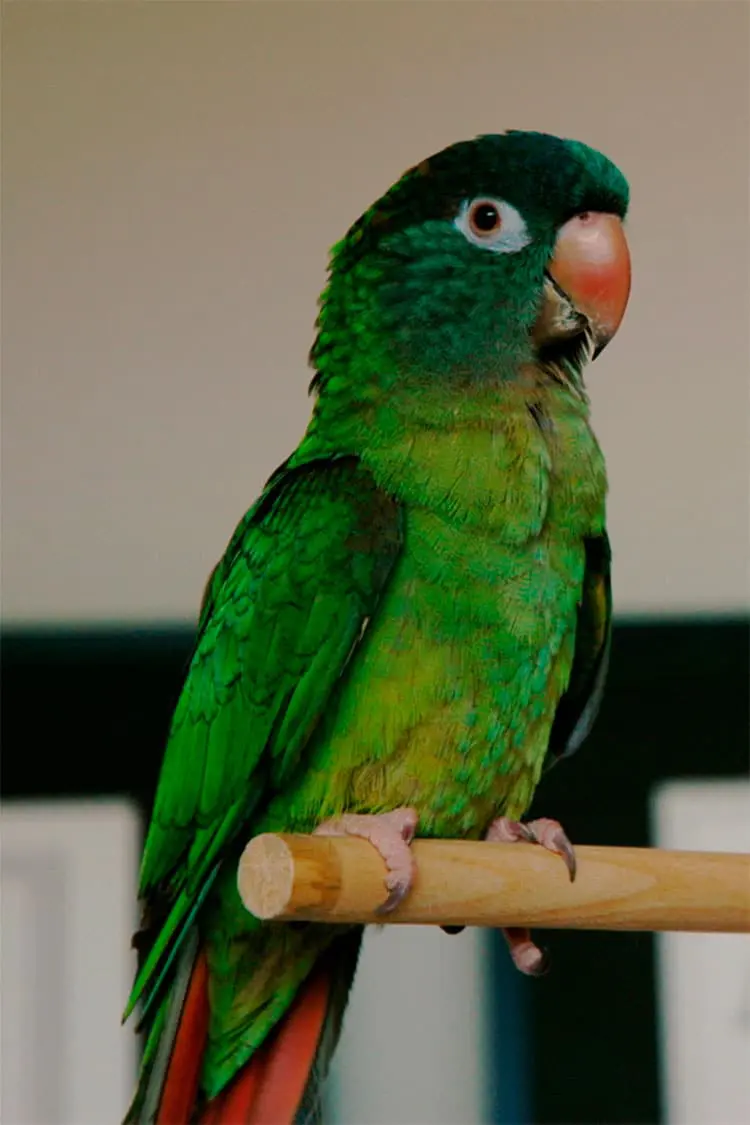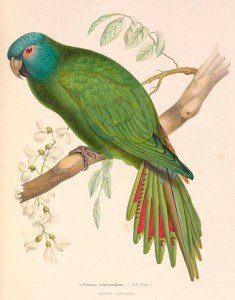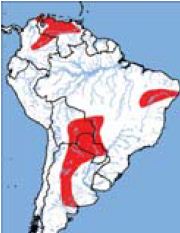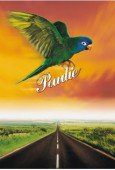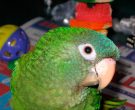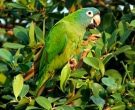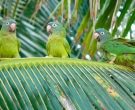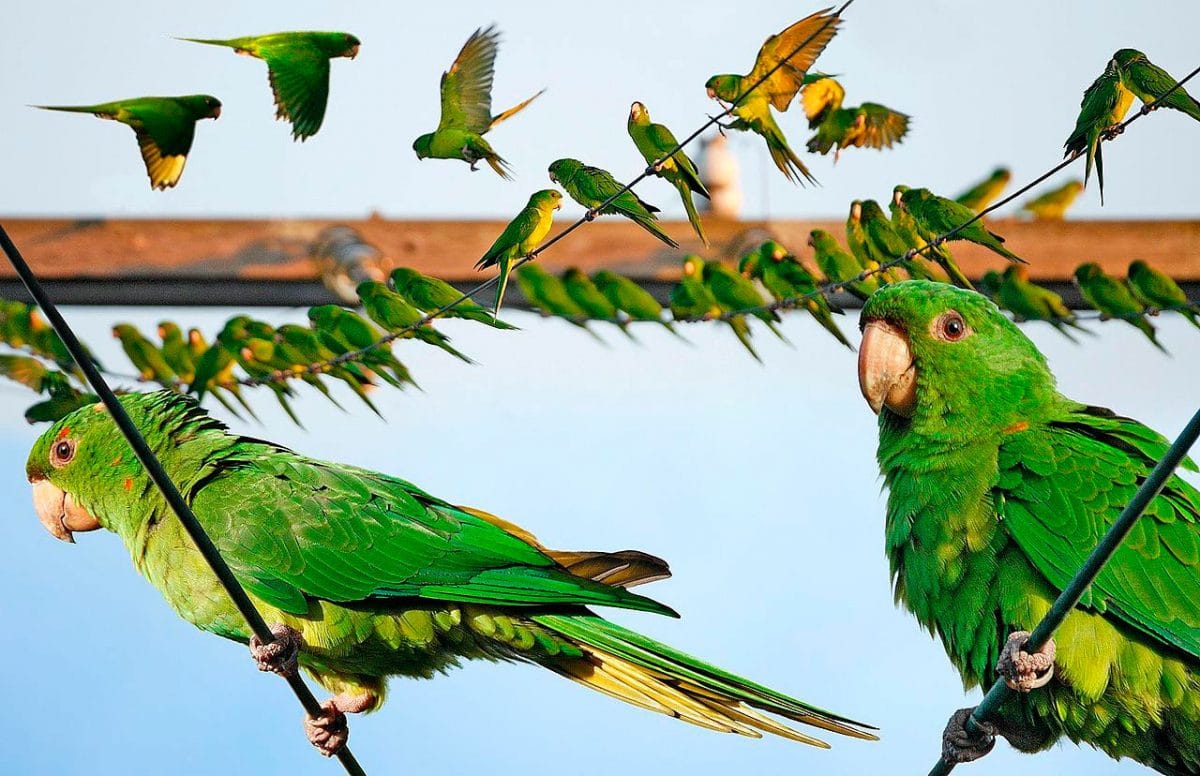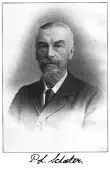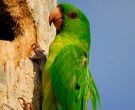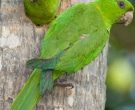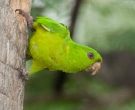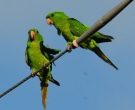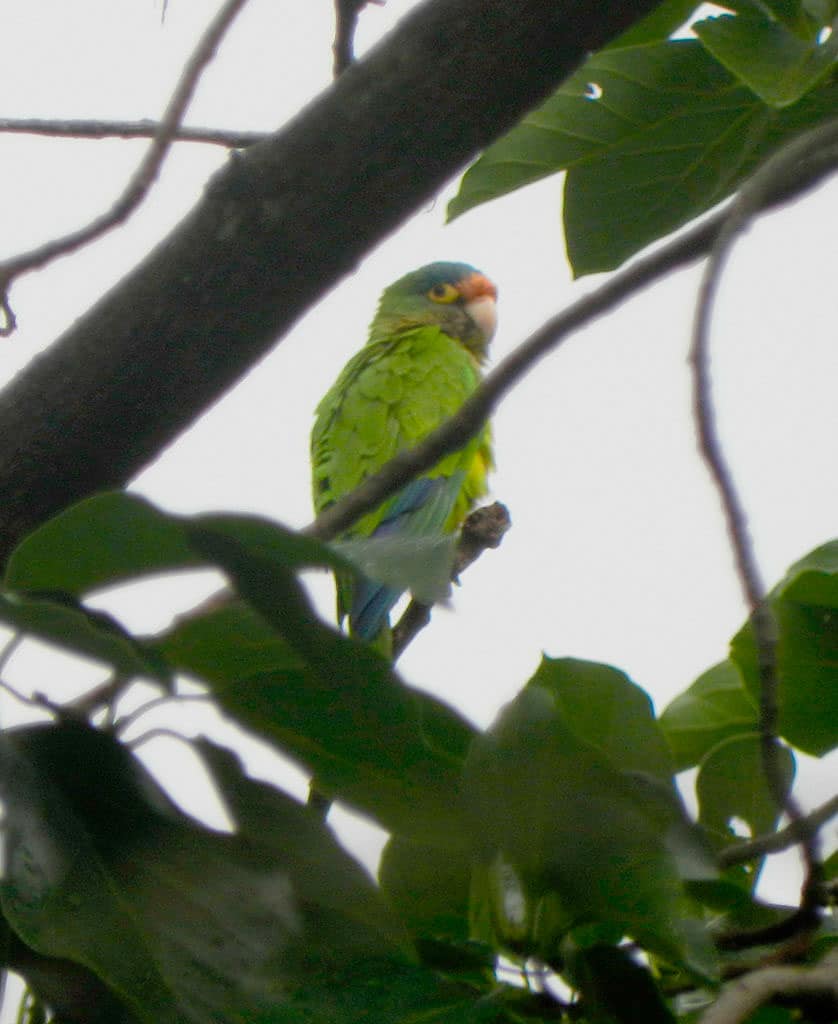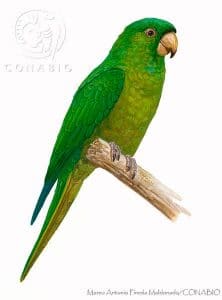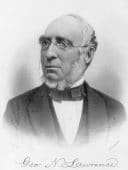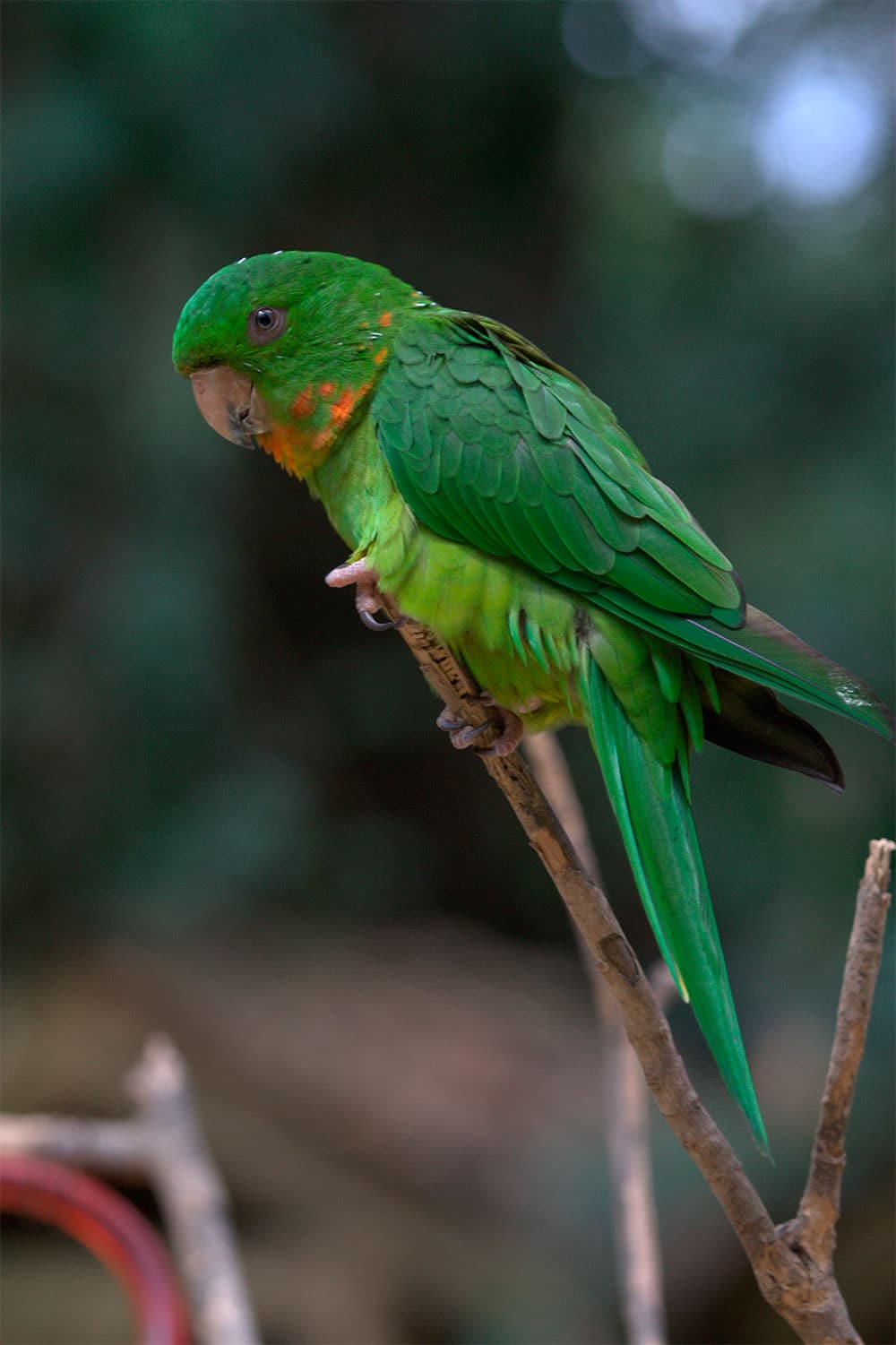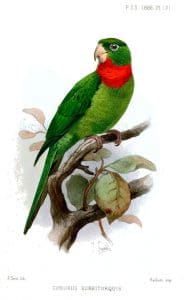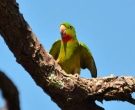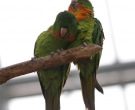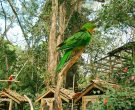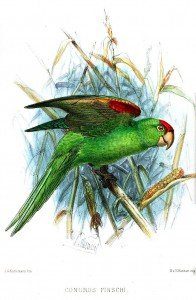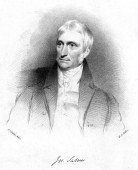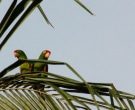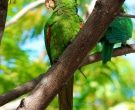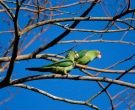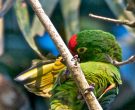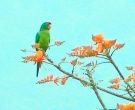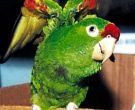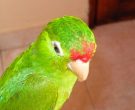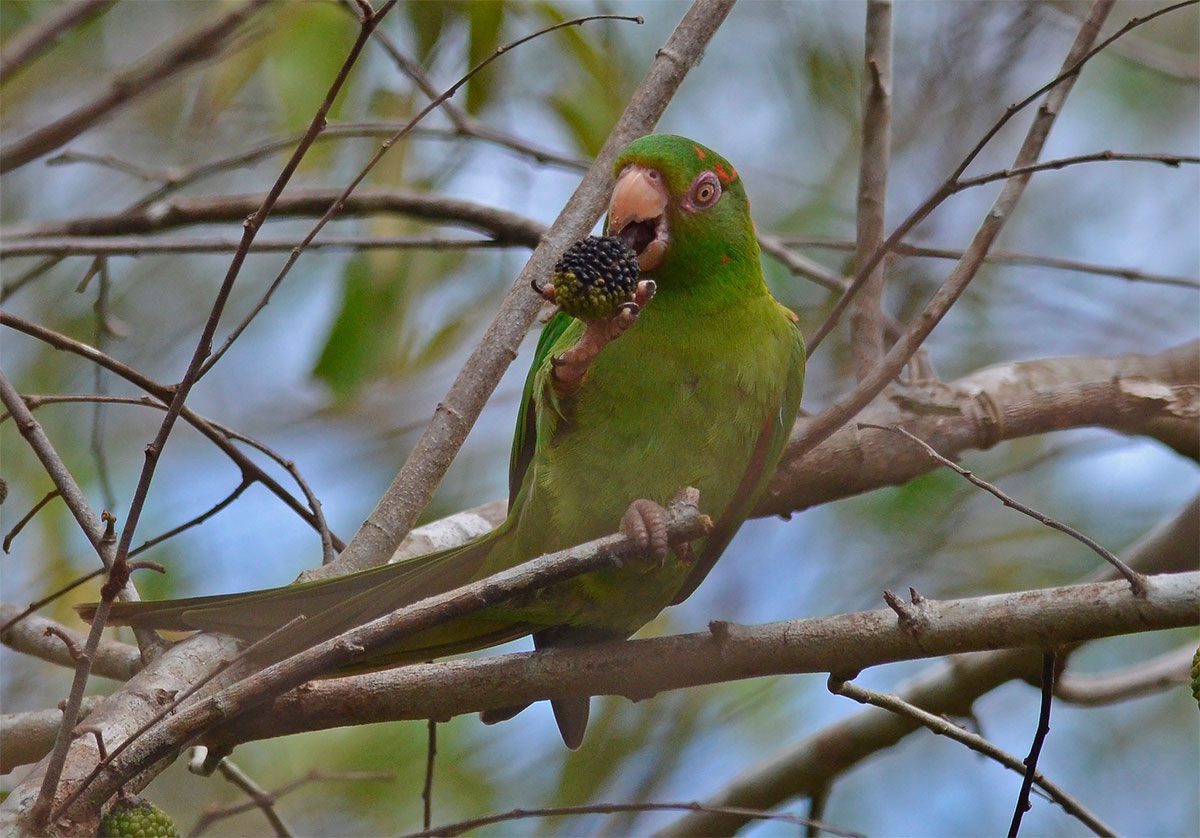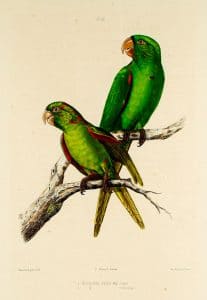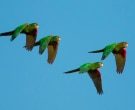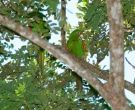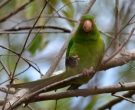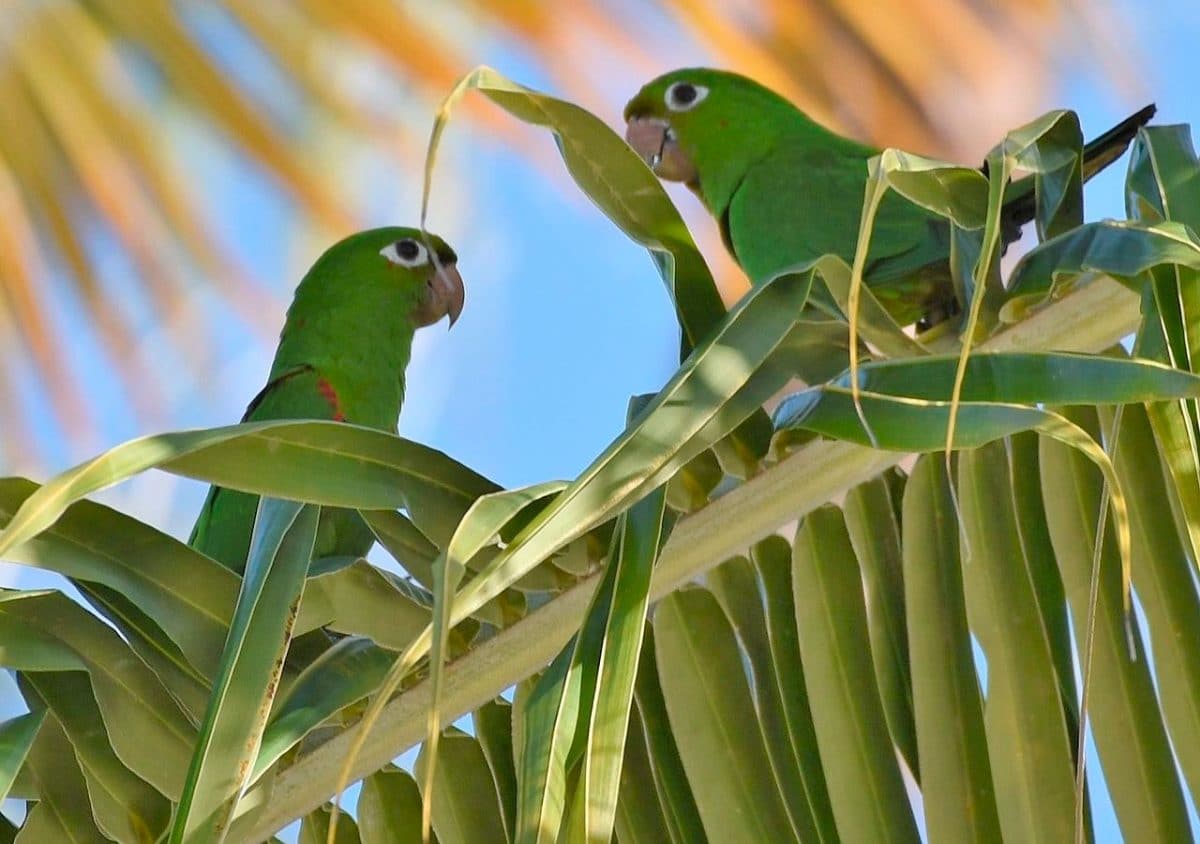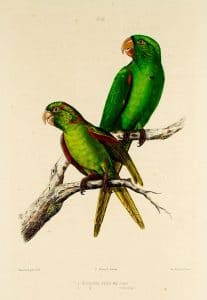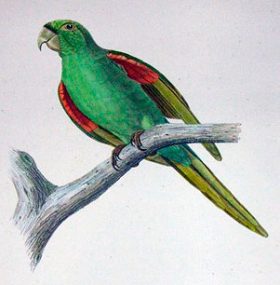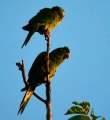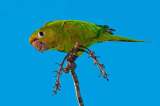Content |
|---|
Description:
33-38 cm.. length and a weight between 170 and 176 g..
The Blue-crowned Conure (Psittacara acuticaudatus) It is one of the largest of the genus birds Aratinga. elongated body, and long tail gradada, equal to all the Aratinga.
You have the front of the crown, the forecrown, the cheeks and lores pale bright blue. The sides of the neck, the nape, the the mantle, scapulars and back are bright green; the rump and uppertail-coverts are green pale. Upperwing-coverts bright green; alula with blue dye.
 Primaries and secondaries green above, with pinkish tinge in the vane inner, olive gold below. Underwing-coverts green.
Primaries and secondaries green above, with pinkish tinge in the vane inner, olive gold below. Underwing-coverts green.
The underparts are pale green with shades of olive green; some feathers of the chest drenched blue. Upper, the tail green color in the vane outer, red brick in the vane inner with fusion of opaque green tips; undertail, the tail Red, distally faded to pale brown brick.
Rosacea the upper jaw, greyish the lower; nude orbital region creamy white; irises yellowish-orange; legs pale pink.
Sexes similar in plumage.
The immature has the blue color of the head restricted to the forecrown and to the crown, no blue tint in the chest. The copies juveniles of the nominal species has bill a paler tone.
- Sound of the Blue-crowned Conure.
Habitat:
Video – "Blue-crowned Conure" |
|---|
The Blue-crowned Conure they live in dry deciduous forests and open habitats including habitats semi-desiertos associated. Registered in the caatinga and the closed with vegetation of Palms Mauritia in the northeast of Brazil, in gallery forest Venezuela and Colombia, deserts in Bolivia, and pampas in Argentina; Also cultivated areas and grassland in dry forest areas.
In general, they live in the lowlands (400 m in Colombia, 600 metres in Venezuela), but ascend to 2650 m in Bolivia, in leguminous forest habitats with columnar cacti.
Usually, in pairs or small flocks, but with larger aggregations outside the breeding season, especially where is food abundant, resulting in considerable local movement and consequent fluctuations in local bird numbers.
In some places, birds roost in crevices of the rocky cliffs. Observed in association with the Mitred Parakeet (Psittacara mitratus) and White-eyed Parakeet (Psittacara leucophthalmus).
Reproduction:
Nest in high tree cavities, among the cultivated species are included as the Mango wave guava; in some areas nested in the cavities of the cliffs sandstone.
The egg laying, generally three to four, takes place in December in Paraguay and Argentina; the brood probably between the months of March and July in Venezuela.
The female incubated eggs during 26 days, and chicks they leave the nest a few 52 days after birth.
Food:
The Blue-crowned Conure they feed in the trees in bushes, and also in land.
Reported foods that make up their diet include seeds of sorghum and Bambusa, berries of Condalia lineata, fruit of Cactus and crops as the Mango Mangifera, possibly also feed on of insects.
Distribution:
Its distribution is discontinuous and wide much of South America. Can be observed in several separate populations from Venezuela to Argentina. One of the largest areas of distribution extends from the northeast of Colombia (to the southeast of the Andes to Department of Meta), including the Guajira Peninsula and Sierra Nevada de Santa Marta in the Northwest of Venezuela to the East of Monagas (including the Margarita Island) and South to the North of Bolívar.
A second population of the Blue-crowned Conure resides in the Northwest of Brazil, to the East of Piauí, North of Bay, Pernambuco and Alagoas. A third You can see from the East of Bolivia and West of Mato Grosso, Brazil, even more to the South, through Paraguay and South of Argentina until The Pampa and southwest of Buenos Aires, perhaps also some individuals in the West of Uruguay.
Pretty common in Colombia. Frequent in Venezuela, although the abundance of birds varies with the season. From just frequent up to quite common in Bolivia. In Northeast Brazil It is most abundant in some locations Parrot. Of common to quite common (but possibly in decline) in the North of Argentina.
Possibly extinct or very rare in West Uruguay. In the Margarita Islands very few examples (between 100 and 200 birds released) the loss of habitat due to tourism, his capture as a domestic fowl, and due to their predation by rats.
There are a large number of specimens in captivity (more than 94.000 birds were exported from Argentina in the period between 1985-1990).
Conservation:
State of conservation ⓘ |
||
|---|---|---|
 Minor Concern ⓘ
(UICN)ⓘ
Minor Concern ⓘ
(UICN)ⓘ
| ||
• Red List category of the UICN current: Least concern
• Population trend: Decreasing
The size of the world population It has not been quantified.
The Blue-headed Parakeet is common in most of its distribution. But like almost all species of parrots, It is threatened by deforestation and the degradation of the habitat.
Some subspecies, in particular the “Psittacara acuticaudatus neoxenus” they are threatened by the cage bird trade. Since 1981 When it was included in the Appendix II, 193,299 individuals were captured in the wild and reported for international trade (UNEP-WCMC trade database CITES, January 2005).
The predation of nests seen as a threat by the rats. But, the Blue-crowned Conure is not considered threatened by now.
"Blue-crowned Conure" in captivity:
Birds are very sociable, very attached to their owners. It is also known have to imitate the human voice, able to learn some words and short sentences.
With regard to its longevity, according to sources, a specimen lived for 31 years in captivity
Its feeding in captivity it is omnivorous and varied, will include sunflower and pumpkin seeds, Tender corn, Green peanuts, oats, wheat, cañamones, In addition to fruits and vegetables: Apple, pear, banana, lettuce, Escarole, etc. During the breeding and fattening, You will be offered biscuit paste and egg yolk.
Until the release of the movie “Paulie“, It presented a Blue-crowned Conure, This species was one of the secrets better kept in poultry production.
Alternative names:
– Blue-crowned Conure, Blue crowned Parakeet, Blue-crowned Parakeet, Sharp-tailed Conure (English).
– Conure à tête bleue, Conure à front bleu, Perriche à tête bleue, Perruche à tête bleue (French).
– Spitzschwanzsittich (German).
– Periquito-de-cabeça-azul, Aratinga-de-testa-azul, Aratinga-de-testa-azul / Periquitão, jandaia-de-cabeça-azul, maracanã, periquitão, periquito-de-bico-rosa, periquito-de-pé-rosa (Portuguese).
– Aratinga Cabeciazul, Calacante común, Calancate, Calancate Común, Loro Cabeza Azul, Maracaná cabeza azulada, Perico Frentiazul, Periquito de Cabeza Azul (español).
– Calacante común, Calancate, Calancate Común (Argentina).
– Calancate (Bolivia).
– Loro frentiazul, Perico Frentiazul (Colombia).
– Maracaná cabeza azulada (Paraguay).
– Loro Cabeza Azul (Uruguay).
– Carapaico, Ñangaro (Venezuela).
– Marakana, Ñendai (Guarani).
scientific classification:
– Order: Psittaciformes
– Family: Psittacidae
– Genus: Psittacara
– Scientific name: Psittacara acuticaudatus
– Citation: (Vieillot, 1818)
– Protonimo: Psittacus acuticaudatus
- Clements, version 2017: Thectocercus acuticaudatus
Images Blue-crowned Conure:
Sources:
- Avibase
- Parrots of the World – Forshaw Joseph M
- Parrots A Guide to the Parrots of the World – Tony Juniper & Mike Parr
- Birdlife
-
Photos:
(1) – Blue-crowned Parakeet, Blue-crowned Conure, or sharp-tailed conure (Aratinga acuticaudata) By John Graziano en:user:Gnocchi [GFDL, CC-BY-SA-3.0, GFDL or CC-BY-SA-3.0], via Wikimedia Commons
(2) – Blue-crowned Parakeet (also known as Blue-crowned Conure and Sharp-tailed Conure) in the square of the small village of San Isidro, Santa Cruz dept, Bolivia By Håkan Sandin [CC BY-SA 2.0], via Wikimedia Commons
(3) – Feral Blue-crowned Parakeets (also knows as Blue-crowned Conure and Sharp-tailed Conure) in Miami, Florida, USA By Kevin from Rotterdam, The Netherlands (threesomeUploaded by Snowmanradio) [CC BY 2.0], via Wikimedia Commons
(4) – A feral Blue-crowned Parakeet in Pompano Beach, Florida, USA By John Spade from Pompano Beach, USA (Guava ThiefUploaded by snowmanradio) [CC BY 2.0], via Wikimedia Commons
(5) – Blue-crowned Parakeet, Blue-crowned Conure, or sharp-tailed conure (Aratinga acuticaudata) By Richard (originally posted to Flickr as Looking at you!) [CC BY 2.0], via Wikimedia Commons
(6) – Conurus acuticaudatus = Aratinga acuticaudata (Blue-crowned Parakeet) Marc Athanase Parfait Oeillet Des Murs [Public domain], via Wikimedia Commons
- Sounds: (Xeno-canto)
